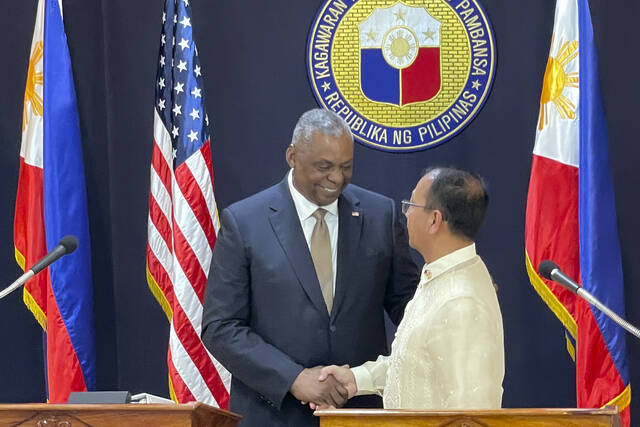How the U.S. is boosting military alliances to counter China
WASHINGTON — The U.S. is expanding it military presence in Asia, in a string of moves aimed at countering Beijing and reassuring Indo-Pacific allies that America will stand with them against threats from China and North Korea.
The U.S. actions stretch from Japan to the Solomon Islands. And they involve more and increasingly advanced military exercises in the region and additional troop rotations in key areas facing the Taiwan Strait and South China Sea. In some cases, they also could provide logistical support in the event of any conflict with China, specifically in defense of the self-governing island of Taiwan, which Beijing claims as its own.
The announcements in recent weeks have triggered angry responses from both China and North Korea. And they come as U.S. Secretary of State Antony Blinken is expected to go to China next week in what will be the first visit by a Cabinet-level official in the Biden administration.
PHILIPPINES
Defense Secretary Lloyd Austin, on his seventh trip to Asia during his two years in office, announced an agreement with the Philippines on Thursday that gives the U.S. access to four more military camps in the Southeast Asian country.
He called it a “big deal” even though it doesn’t establish a permanent U.S. military presence, which is prohibited under the Philippine Constitution. What it does do, however, is give U.S. troops — rotating in and out of the Philippines — a bird’s eye view of two critical spots: the Taiwan Strait and disputed regions of the South China Sea.
There are about 500 U.S. troops in the Philippines on any given day, but thousands rotate in and out over the course of a year for military exercises, humanitarian aid, training and other missions, according to officials. The Philippines allows American forces to stay in barracks within designated Philippine camps. The U.S. already had access to five Philippine military bases.
Standing with his Philippine counterpart, Carlito Galvez Jr., during a press conference in Manila, Austin said the efforts to strengthen the alliance “are especially important as the People’s Republic of China continues to advance its illegitimate claims in the West Philippine Sea.”
In response, China’s Foreign Ministry spokeswomen Mao Ning accused the U.S. of pursuing “its selfish agenda” with the new arrangement, calling it “an act that escalates tensions in the region and endangers regional peace and stability.”
SOUTH KOREA
In Seoul on Tuesday, Austin announced that the U.S. would increase its deployment of advanced military assets to the Korean Peninsula, including fighter jets and aircraft carriers to boost joint training and planning.
He and South Korean Defense Minister Lee Jong-Sup agreed to expand their combined military exercises, including more live-fire demonstrations. And they discussed preparations for a simulated exercise in February aimed at sharpening their response if North Korea used nuclear weapons.
North Korea test-fired dozens of missiles in 2022, including potentially nuclear-capable ones designed to strike targets in South Korea and the U.S. mainland.
The U.S. resumed large-scale military drills last year, including an aerial exercise involving U.S. strategic bombers in November, in a stepped-up effort to deter Pyongyang. The allies had scaled back exercises in recent years to create room for diplomacy with North Korea during the Trump administration and because of the COVID-19 pandemic.
North Korea, in response, said it’s prepared to counter U.S. military moves with the “most overwhelming nuclear force.” It said the expansion of military exercises is pushing tensions to an “extreme red line.”
JAPAN
Last month, the U.S. and Japan agreed to adjust the American troop presence on the island of Okinawa in part to enhance anti-ship capabilities that would be needed in the event of a Chinese incursion into Taiwan or other hostile acts in the South or East China sea.
They also added a formal mention of outer space in the longstanding U.S.-Japan security treaty, making clear that “attacks to, from and within space” could trigger the mutual defense provisions of the treaty. And Japan announced it would begin constructing a pair of runways on the small southern island of Mageshima where joint exercises, amphibious operations and missile interception could begin in about four years.
The island would be a hub for troop deployments and munition supplies in case of a conflict like a Taiwan emergency.
The changes in the U.S. deployment on Okinawa will transform the 12th Marine Regiment into a smaller, more rapidly mobile unit — the 12th Marine Littoral Regiment, which will be better equipped to fight an adversary and defend the U.S. and its allies in the region.
SOLOMON ISLANDS
On the diplomatic front, the U.S. opened an embassy in the Solomon Islands this week, in a direct effort to counter China’s growing influence there. There had been an embassy in the Solomons for several years, but it was closed in 1993 as part of a global reduction in diplomatic posts. Over time, however, the U.S. became concerned about possible weakening ties with the country.
The Solomon Islands switched allegiance from the self-ruled island of Taiwan to Beijing in 2019. And last year, the Solomons signed a security pact with China, raising fears of a military buildup by Beijing in the region.
Reopening an embassy there, the U.S. State Department said, was a priority to counter China’s growing influence in the region. The embassy in the capital, Honiara, is starting small, with a chargé d’affaires, a couple of State Department staff and a handful of local employees.
Remove the ads from your TribLIVE reading experience but still support the journalists who create the content with TribLIVE Ad-Free.






